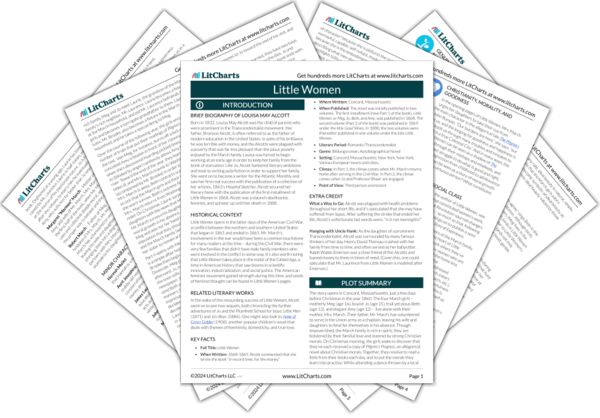Welcome to the LitCharts study guide on Louisa May Alcott's Little Women. Created by the original team behind SparkNotes, LitCharts are the world's best literature guides.
Little Women: Introduction
Little Women: Plot Summary
Little Women: Detailed Summary & Analysis
Little Women: Themes
Little Women: Quotes
Little Women: Characters
Little Women: Symbols
Little Women: Literary Devices
Little Women: Quizzes
Little Women: Theme Wheel
Brief Biography of Louisa May Alcott

Historical Context of Little Women
Other Books Related to Little Women
- Full Title: Little Women
- When Written: 1868-1869. Alcott commented that she wrote the book “in record time, for the money.”
- Where Written: Concord, Massachusetts
- When Published: The novel was initially published in two volumes. The first installment (now Part 1 of the book), Little Women: or Meg, Jo, Beth, and Amy, was published in 1868. The second volume (Part 2 of the book) was published in 1869 under the title Good Wives. In 1880, the two volumes were thereafter published in one volume under the title Little Women.
- Literary Period: Romantic/Transcendentalist
- Genre: Bildungsroman, Autobiographical Novel
- Setting: Concord, Massachusetts; New York, New York; Various European towns and cities.
- Climax: In Part 1, the climax comes when Mr. March returns home after serving in the Civil War. In Part 2, the climax comes when Jo and Professor Bhaer are engaged.
- Point of View: Third person omniscient
Extra Credit for Little Women
What a Way to Go: Alcott was plagued with health problems throughout her short life, and it’s speculated that she may have suffered from lupus. After suffering the stroke that ended her life, Alcott’s unfortunate last words were, “Is it not meningitis?”
Hanging with Uncle Hank: As the daughter of a prominent Transcendentalist, Alcott was surrounded by many famous thinkers of her day. Henry David Thoreau crashed with her family from time to time, and often served as her babysitter. Ralph Waldo Emerson was a close friend of the Alcotts and loaned money to them in times of need. (Given this, one could speculate that Mr. Laurence from Little Women is modeled after Emerson.)












